A Caribbean Birding Adventure Part I - St Lucia
Five years ago, I had never heard of the Lesser Antilles, then our friend Ryan Chenery told us about his new birding company Birding the Islands. Ryan is Bajan, born and bred in the Antilles, a near endemic birding guide! Like all the best birding tour companies all of his guides are local and they really need our support in these difficult times, especially after tourism restrictions brought about during Covid. His offer to put together a tailor-made trip was therefore too good an opportunity to resist. We were also on a different kind of mission; my partner Jo Ruth wanted to see the bird on Ryan’s company logo which she designed, the beautiful Red-billed Tropicbird.
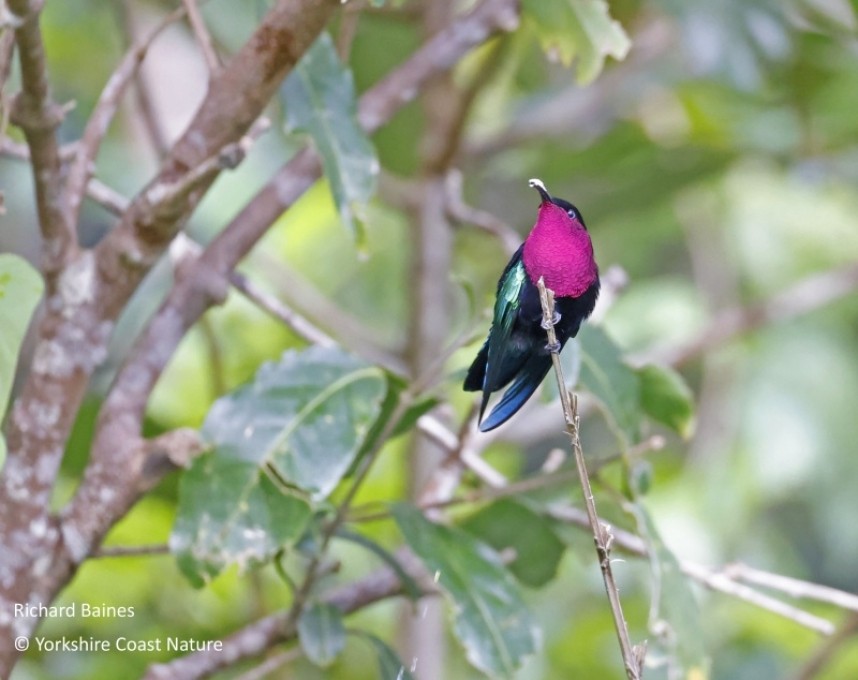
Purple-throated Carib - St Lucia Nov 2022 © Richard Baines
We arrived on St Lucia on the 11th November 2022 on a hassle-free direct flight from Gatwick. Our first stay was at the Balenbouche estate, a beautiful family run, sustainable retreat set in lush tropical gardens, ideal for a first taste of wildlife in the Lesser Antilles. The private lodges in the estate garden meant we could enjoy sights and sounds in peace and tranquillity.
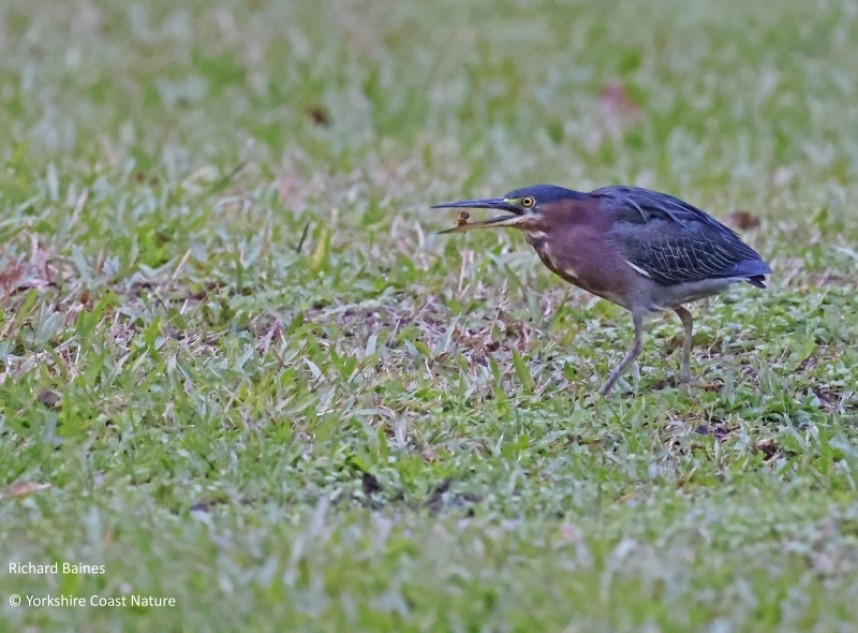
Green Heron - St Lucia Nov 2022 © Richard Baines
A Green Heron perched on our cabin step greeted us when we arrived. My own personal birding vision is all about taking the time to ‘drink in the birds’. Learning slowly about species, habitat and other wildlife such as the local insects and plants. Our first two days were a great success, lots of chilled birding exploring the estate, time to finding and learn all these new tropical treats.
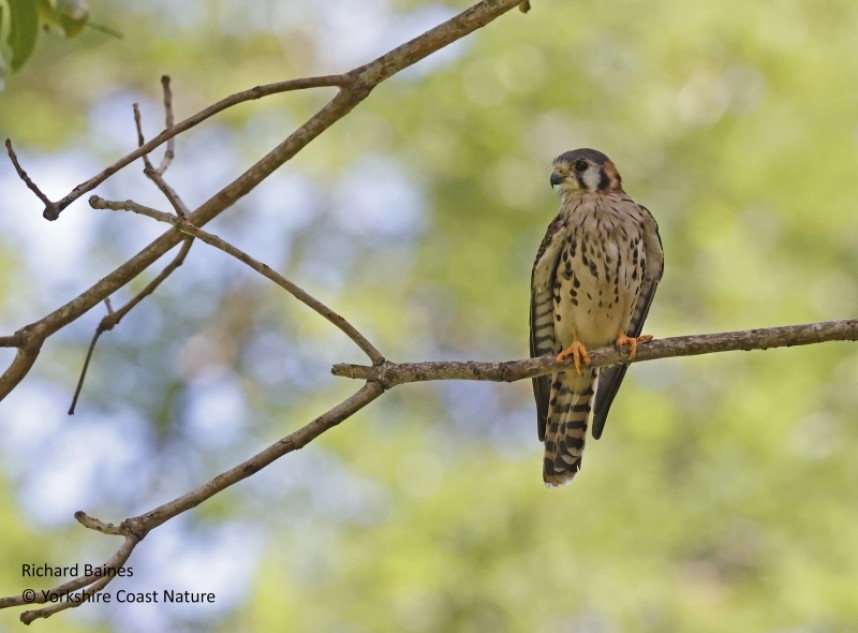
American Kestrel - St Lucia Nov 2022 © Richard Baines
I soon discovered a very tall mature tree close to our cabin which was very popular in the early morning for a bird which looked and sounded like a thrush. After a while I saw the distinctive beady eyes and breast markings of a Scaly-breasted Thrasher. Nearby an American Kestrel and a Grey Kingbird gave fantastic views and I could hear the distinctive calls of hummingbirds. A short time later I had seen all three species found on St Lucia; Antillean Crested Hummingbird, Green-throated Carib and Purple-throated Carib. For such small birds I am constantly amazed at how charismatic hummingbirds are.
Tiny and very pretty Common Ground Doves fed under the trees alongside beautiful Zenaida Doves and the very common Lesser Antillean Bullfinch. I didn’t realise how cool and confident these finches were until I had literally shared my breakfast Mango with a male! By the end of the trip we had welcomed these amazing birds into all of our lodgings.
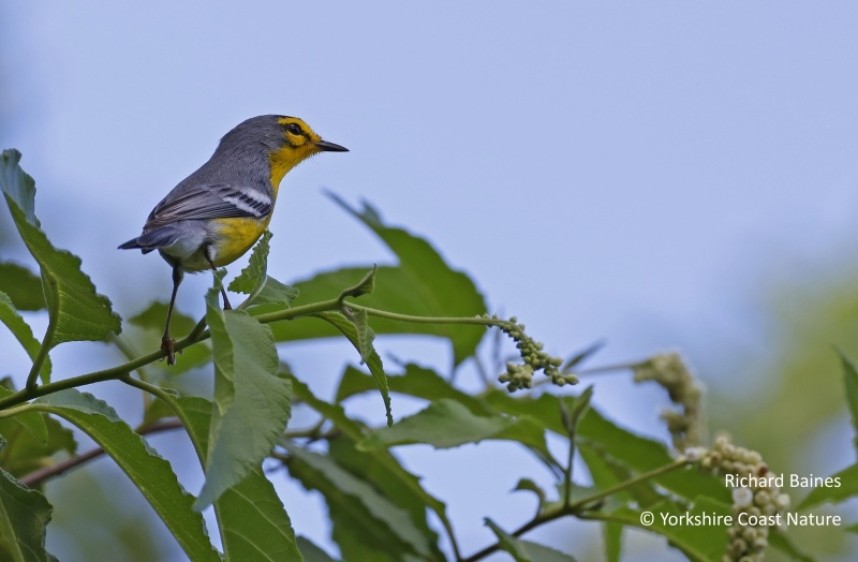
St Lucia Warbler - St Lucia Nov 2022 © Richard Baines
On our third day we were picked up by Willow, our first birding guide who worked for the local Birding and Wildlife Ambassadors guiding service. Willow is a very proud Rastafarian with a great love of his island and its native birdlife. The key birds during our two days with Willow were five St Lucian Endemics; Antillean or St Lucia House Wren (subspecies musicus), St Lucia Parrot, St Lucia Oriole, St Lucia Black Finch, St Lucia Warbler and many other subspecies and near endemics which are found on a small number of islands in the Lesser Antilles and nowhere else in the world.
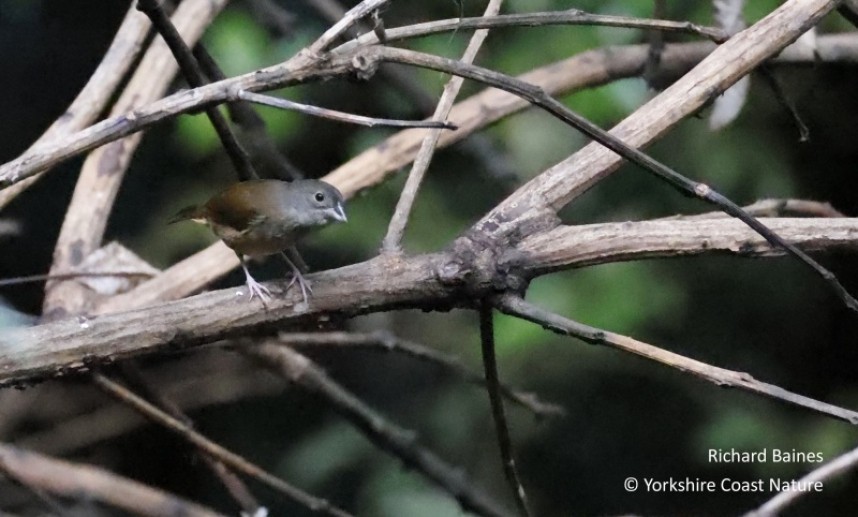
Black Finch (female) - St Lucia Nov 2022 © Richard Baines
Our first stop was a classic birders roadside stake out, innocuous and tatty, ideal for a wren, Not long afterwards out of the tangle popped a pale bellied songster in the form of an Antillean House Wren. A short drive later we were on a hillside overlooking secondary growth forest at the end of a hidden track that no other visitors would ever think about driving down, other than crazy-eyed birders.
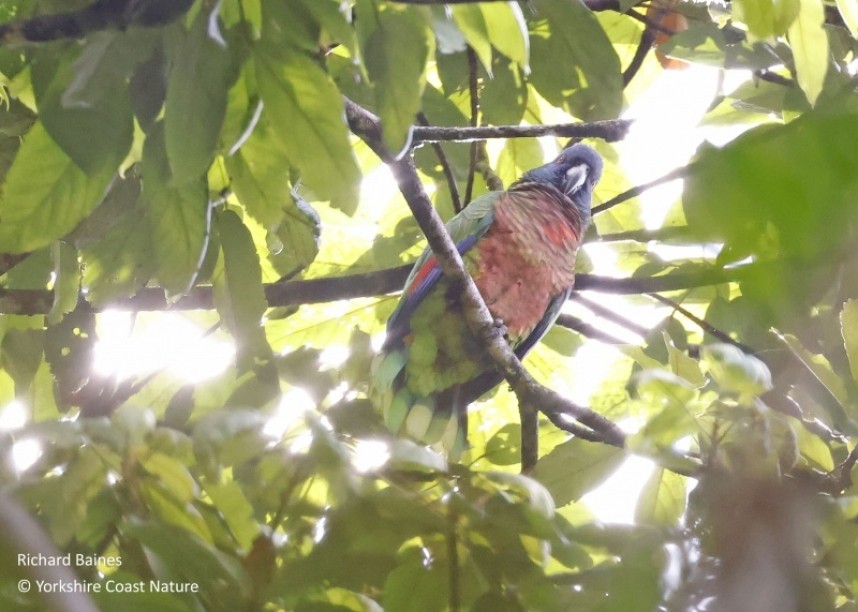
St Lucia Parrot - St Lucia Nov 2022 © Richard Baines
Standing by the car we saw our first enigmatic views of St Lucia Parrots, a family group of four flying over the forest. Close by, giving great views was a Mangrove Cuckoo and a very confiding Lesser Antillean Pewee. Willow’s keen ears detected the calls of Black Finches in the undergrowth but these forest floor dwellers were staying out of view. Armed with the knowledge of their calls we were later able to find a pair at close quarters.
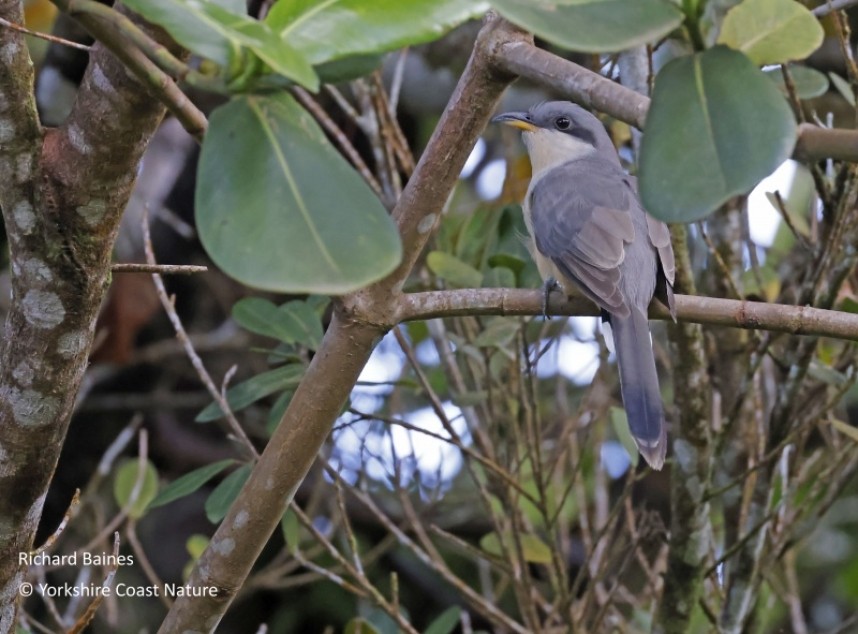
Mangrove Cuckoo - St Lucia Nov 2022 © Richard Baines
A Black-whiskered Vireo joined a group of foraging Bananaquits whilst overhead a flock of Swifts contained both Lesser Antillean and Short-tailed. One of the last birds to capture our imagination at this site was the amazing Grey Trembler, a near endemic and one of two tremblers in the Antilles. The fast, wing trembling was a crazy and wonderful thing to see as this yellow eyed, long billed, thrush sized bird kept us entertained in the trees before vanishing back into the forest.
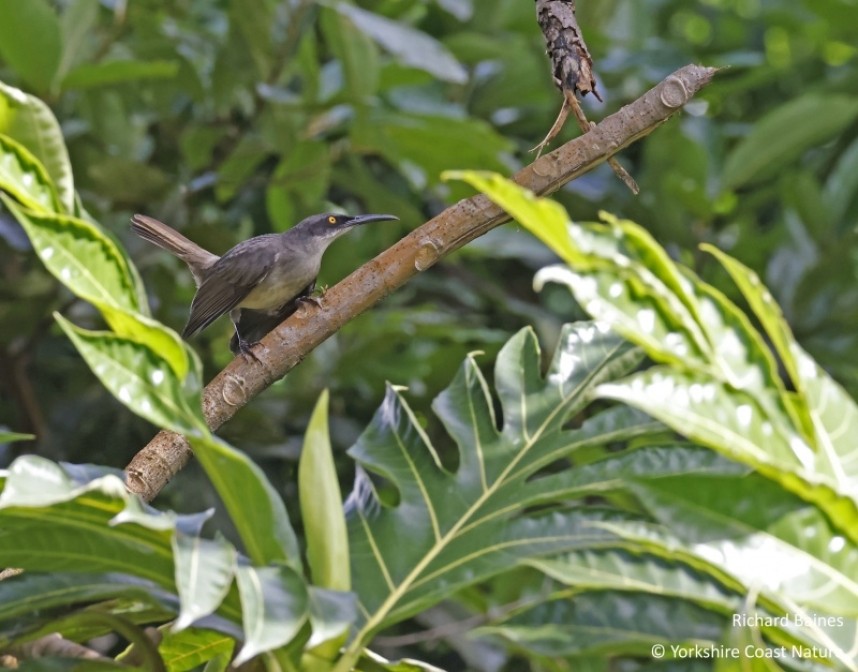
Grey Trembler - St Lucia Nov 2022 © Richard Baines
After lunch at a roadside restaurant, we travelled to Cape Moule a Chique, one of the southernmost headlands on the coast of St Lucia. Perched above towering cliffs on a windswept cape it almost felt like I was back home in Yorkshire, stood on Flamborough Headland but the temperature was a bit different!
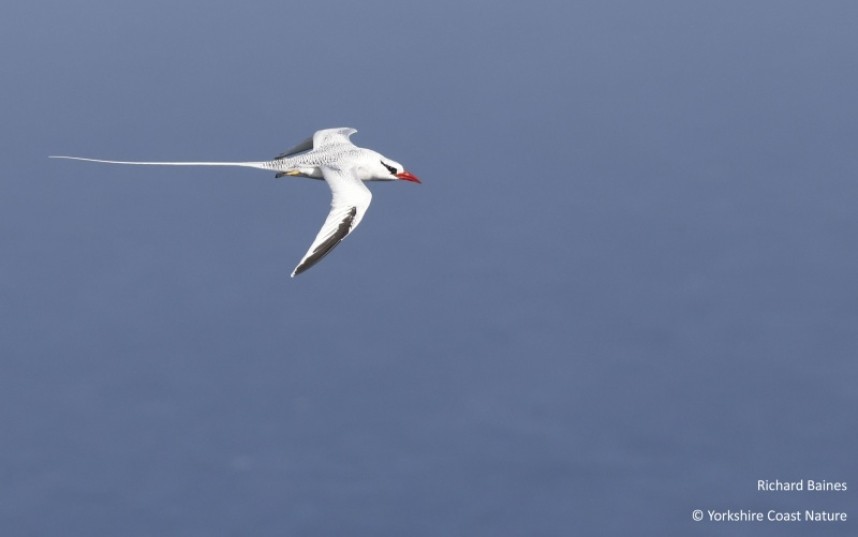
Red-billed Tropicbird - St Lucia Nov 2022 © Richard Baines
As we walked towards the old lighthouse, I heard what sounded like bickering terns, these were not terns though, these were Red-billed Tropicbirds! This was a real wow moment as a group of six flew close by displaying and calling to each other sporting their incredibly long tail streamers, blood red, dagger bills and their bandit like black masks. We spent a very magical couple of hours watching these magnificent seabirds on our own with the wild Atlantic on one side of us and the tropical Caribbean Sea on the other.
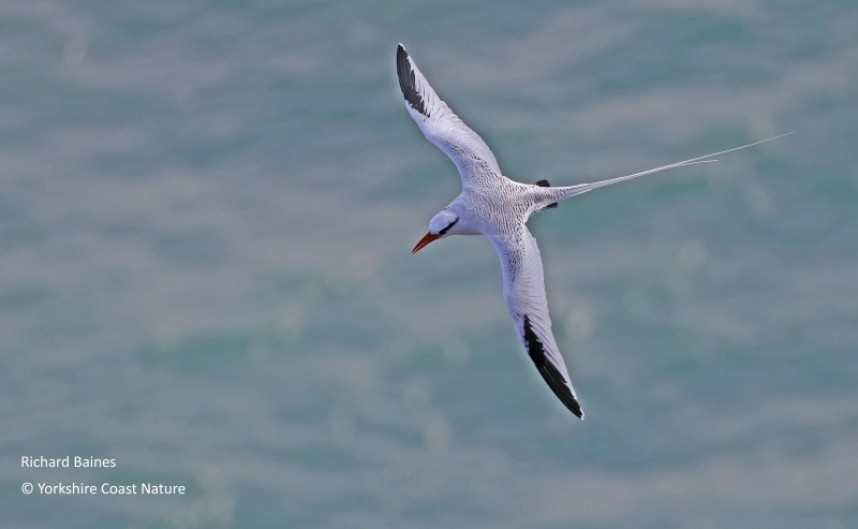
Red-billed Tropicbird - St Lucia Nov 2022 © Richard Baines
There were at least 30 tropicbirds in small groups beneath us and occasionally flying over the grassland at point blank range with such grace. They return to these nesting cliffs regularly during the non-breeding season before moving back out to sea to feed. After several more days on St Lucia and lots of time peering out to sea, I realised just how special this headland was. There is very little chance of seeing a Red-billed Tropicbird anywhere from the coastline of these islands because they travel so far out over the ocean to feed. The cliffs of Cape Moule a Chique made a big impression on us; amazing scenery, a wildness free of disturbance and windswept with only us and the tropicbirds. We were alone with one of the most iconic seabirds in the world and a wonderfully warm Caribbean breeze.
Our final day with Willow was focused on the tropical forest reserve on the Des Cartiers Trail. Willow asked me which bird would I really like to see in the forest, my answer was a bird which makes one of most wonderful sounds in the world, a Rufous-throated Solitaire. Our first experience was the sound, three or four, long, leaning notes, clear as a bell, beautiful and yet haunting like the only sound left on a ghost ship cast adrift in a sea of trees. The only other sounds washing over us were from the crickets and tree frogs, the full orchestra created a blissful hidden symphony.
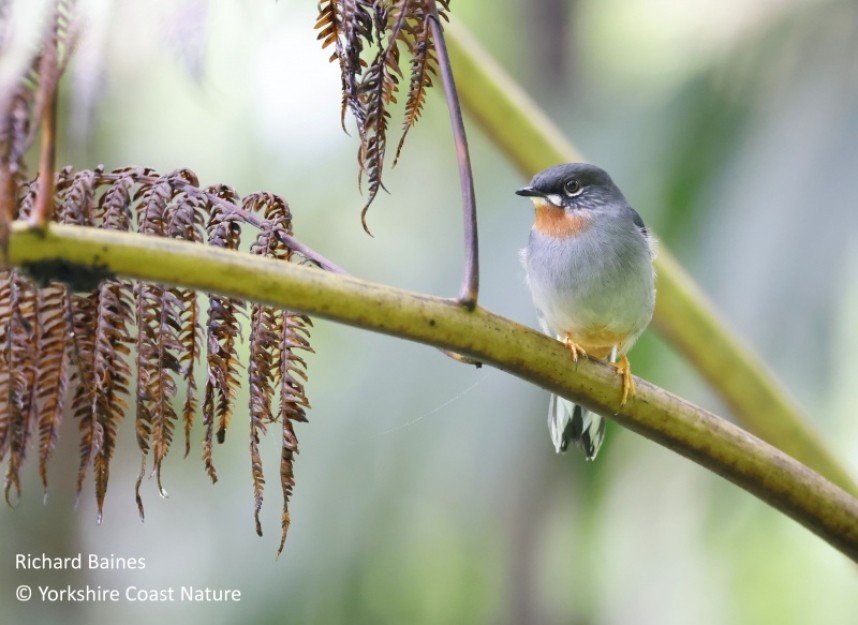
Rufous-throated Solitaire - St Lucia Nov 2022 © Richard Baines
Solitaires can be very elusive, when they are sitting so still you can walk straight past them without knowing they area there. Cue my best tried and tested strategy; forget about your quarry then just like magic… At the main viewpoint whilst searching for parrots, not one but two Rufous-throated Solitaire’s appeared from under the huge leaves beside us. Our second day was off to a great start!
From this narrow lookout we peered across this magnificent tropical forest. In the distance we could hear the calls of St Lucian Parrots echoing around the canopy. After a patient wait a male and female gave excellent views in the tree tops. In the same area, Willow helped us see loads of other great birds; Lesser Antillean Euphonia, St Lucia Oriole, St Lucia Warbler, Lesser Antillean Flycatcher, Pearly-eyed Thrasher and great views of hunting Broad-winged Hawks.
Our final challenge on the birding trail of charismatic endemics was the St Lucian White-breasted Thrasher (subspecies sanctaeluciae), a bird of dry low forest and scrub. It didn’t take long to locate a pair hopping around on the ground and low trees, to our European eyes they looked like huge Brown-throated Dippers in a woodland! We had to be extra careful in this habitat because the famously deadly fer de lance pit viper prefers drier forest environments.
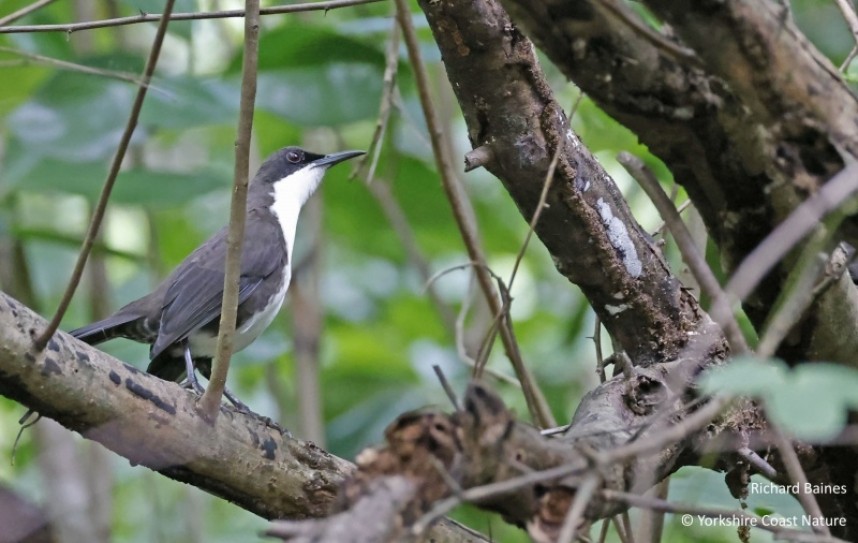
White-breasted Thrasher - St Lucia Nov 2022 © Richard Baines
On our drives between birding sites in the forest there were many opportunities to stop by the coast. The Caribbean western side was much calmer than the wild Atlantic eastern seaboard. What a difference, like another world! Around the many fishing villages small numbers of seabirds hung around offshore. Magnificent Frigatebirds effortlessly shot the breeze, spending large amounts of time on the wing without a single flap. They are the master scavengers of the Antilles. No gulls to be seen anywhere, maybe it’s hardly surprising when these huge frigates bossed the skies. Sneaking in amongst the Magnificent Frigatebirds were small numbers of Royal Terns, one Cabot’s Tern, the odd Brown Booby skimming the waves and a few barrel-chested Brown Pelicans always looking comical and awesome in equal measure as they plunge bill first into the sea.
St Lucia had been great; it was now time to catch the ferry to Dominica and meet the famous Dr Birdy! Read Part II CLICK HERE.
© Yorkshire Coast Nature



 Back to Blog
Back to Blog
